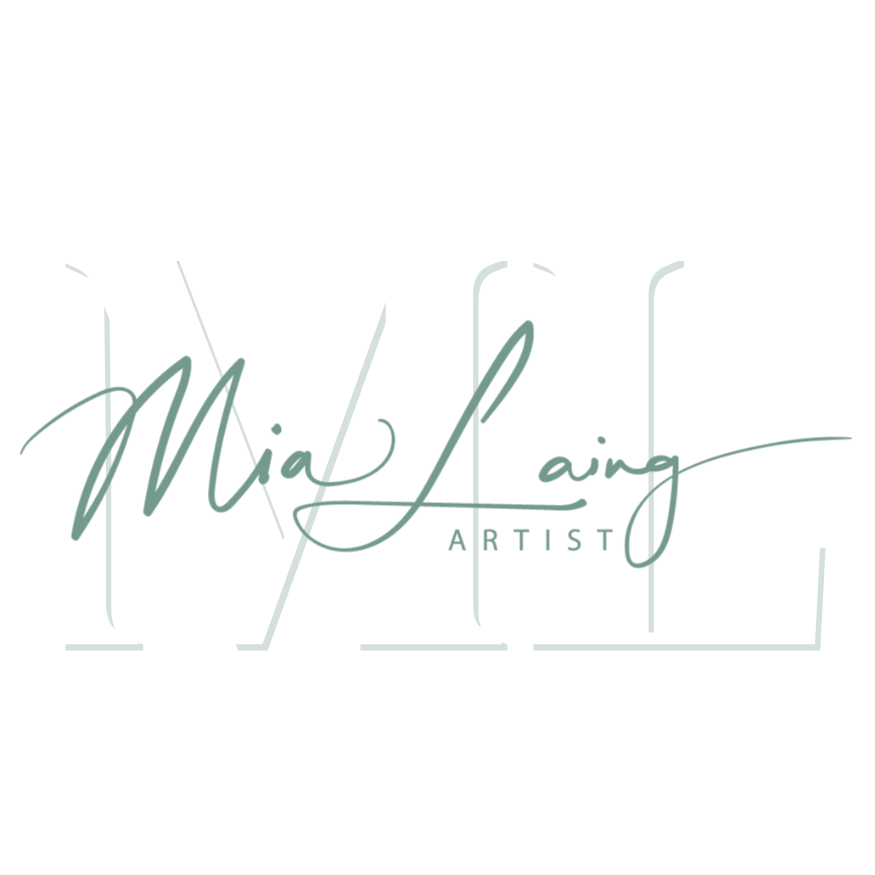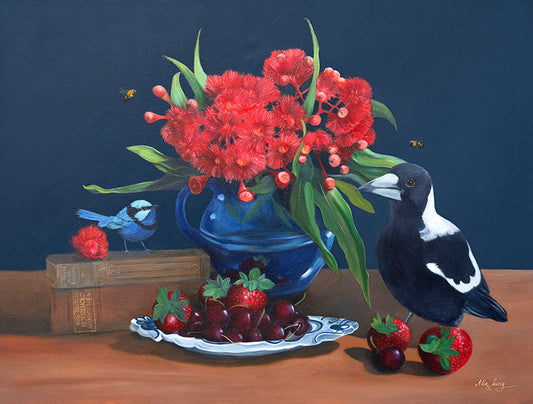Let's talk about the importance of using quality art materials...from the very start of your art journey.

Im a stickler for this, so much so, I've already blogged about this before (I've rewritten parts of it in this post) and Im sure to write it again and again.
Quality Matters When Choosing Art Materials, for both you, the artist, and your art collectors.
If you have any inclination to sell your art and want to be taken seriously, using professional, artist quality supplies from the beginning will serve you well.
You may be new to art, just finding your way, or an emerging artist, experiencing the first thrills of having made an art sale. Its easy to believe you are still learning and therefore can get away with student quality materials...but think again. It's not now, but a few years down the track when these decisions will leave you with a headache.
When I talk materials, I am discussing:
Paint of your chosen medium...Oil, acrylic, watercolour, pencil and so forth.
Art supports such as stretched canvas, boards, paper...the material that adheres paint.
Framing or display methods.
Solvents, mediums, and varnishes.
If you are selling your art, or even considering selling it in the future, it is a product you are offering that has consumer protection rights attached to it. Offering cheap and poor quality materials could come back to damage your reputation and your finances.
Ive heard stories of expensive and bespoke original artworks falling off the wall and being damaged, because the cheap frame the beautiful artwork was put in, fell apart over time. Ive seen cheap stretchers, entered into art awards, that are warped and not sitting flush to the wall. Ive personally had cheap canvas (from my very, very early student days) disintegrate, with meaningful portraits of my girls painted on them. Cheap means mass production and not built to last and the archival properties of these products are significantly reduced. I learnt this lesson the hard way.
'But I'm Still Learning'...
Even for student or emerging artists, there are savings to be made by investing in a smaller quantity of artist grade paints, as opposed to a larger quantity of student grade...a saving on your time and frustration levels. It will take three coats of a poor quality paint to get the desired finish you want, compared to one of a higher quality. Its unbelievably frustrating to be at the mercy of what your cheap materials will allow you to achieve and when learning, this can put you off advancing and enjoying the process. The learning curve from using artist quality materials will be far steeper and more rapid and be of a greater enjoyment than that of using inferior products.
I get that in the early stages of learning your craft, and even as an advanced painter, there are definitely times when its okie to use cheaper materials, such as when you are experimenting. Butcher paper is fabulous for quick and flowing charcoal sketches; old bits of cardboard can be handy for swatches of colour or to practice blending. Inexpensive sketch books can be a brilliant place to do daily sketches. Taking away the pressure to produce an amazing artwork is a key aspect to learning and improving, but if you have any plans to sell it, go straight for the better quality materials. The art made on cheap stuff... Give it away to a loving family member, or better still, hide it in the attic, just so you can look back at how much you have improved over time.
Quality Matters
Yes, artist quality materials are more expensive to begin with, but when you get to the stage of regularly selling artworks, these costs become part of the selling price. Over time and as your reputation as an artist increases, with positive customer reviews and return collectors, these costs become part of your process. Keep a bank account purely for your art business. Slowly over time, the sales and incomings will negate the out goings. It takes time but it does happen.
Subscribe to your favourite art supply store to know of specials or discounts. Check facebook marketplace, Gumtree, and online second hand markets for art materials...it's far better to have good quality used, than poorer quality new.
Good reviews and testimonials will get you new buyers. When people trust your quality and see value for what they are paying, you will get collectors...that is, people who come back to buy more pieces. There is nothing better than return customers and return customers will always bring friends with them! Reputation speaks loud.
I've had MANY return customers on both my webpage and at my representing galleries such as Bluethumb. My testimonials have spoken of the quality finish and professionalism clients receive. Quality Matters.

Why You Should Use Artist Quality Art Materials (Updated from 2018)
- Artist quality materials will (mostly) be archival. Archival means longevity and durability. I write 'mostly' because they will only be archival if you are following technical advice, material knowledge and environmental factors to ensure archival longevity. Student quality materials are mass-produced, using inferior materials and pigments and are NOT archival. You get what you pay for...fading and cracking will be your enemy.
- Artist quality Stretchers and supports will be stronger and shouldn't warp. Their Angles should be sharp and correct. There's nothing quite so bad as a beautiful painting on a warped stretcher...no matter how beautiful, your eye will always be drawn to the fact it just isn't straight or hangs oddly on the wall. Better than buying pre made, buy a roll of canvas and get your local framer to make to your exact specifications and dimensions.
- Artist quality canvas and linen is a joy to work on. Many will be double primed (or even triple primed) with archival gesso and be of a heavier weight, therefore offering a tight canvas for application of acrylics or oils. Tight canvas remains tight even in high humidity. Cheap canvas stretchers will often buckle and sag in high heat conditions and is often gessoed in house paint. Chalky, chemical laden and not a great ground for your oils or acrylics. The student quality canvas often breaks down over time, with the fibres becoming brittle and dry, leading to ripping at the edges.
- Framing can be done cheaper on artist quality supports. Yes, you read that right, cheaper. If a framer is given a stretcher that is warped, they will need to re-stretch the piece before framing, effectively doubling your frame costs. Ouch. Believe me, I've had this happen with one of my very early pieces and it really hurt the finances.
- Artist quality professional paints offer better colour and adhesion and are archival when you follow the correct application. Quality speaks...you will never see a brighter colour than that which is made with dedication and refined pigments. You will need to use less paint when its made of quality pigments, thereby saving you money once again. See where I'm going with this? Short term pain equals long-term gain! My favourite brand is Australian made Art Spectrum.
- Professional acrylics dry truer to colour making repainting easier with less layering needed....a cost and frustration saver. I never felt comfortable under painting in acrylics until I tried a professional artist brand, the difference to the adhesion of my oils over the top was incredible and I now safely use them in my base layers.
- Want to be forever struggling with your art? Inferior pigment, fillers and poor quality will leave you as blue as your faded paint. Cheap stuff behaves and looks cheap and will slow the advancement of your skills.
- Artist grade meets all the industry standards, are competitive across brands vying for your dollar, giving you durability, awesome pigments and a whole lotta magic. Try comparing an artist grade and a student grade paint tube and you will notice a missing batch code on the cheap stuff. Colours vary from batch to batch and professional standards will acknowledge and account for this with a batch code system, therefore making our lives easier when sourcing that perfect product or colour.
- With new advancements in technology, artist grade mediums and paints are safer than the cheaper ones. Take solvents for example...solvents from your local hardware store are very inexpensive...but present challenges to keeping your working practise and studio safe from fumes. New solvents, such as the one I use, Langridge Solvent 75 is the safest solvent available and the bigger price tag is one I will happily pay for my health.
- You would think buying cheap brushes and just ditching them after a few sessions is the way to go, but you will be surprised what a better quality brush will do for your painting. Fighting with splayed bristles, lack of bounce or paint hold and pesky dropped fibres can really deter the natural flow of your art. Yes, I use cheap brushes for underpainting and some fast and furious laying down of colour, but once I get into my detailed work, quality is always the brush I hold. Im not sponsored, but Rosemary and Co brushes have my tick of approval for durability and quality.
I know its hard to pay more when there is cheaper on offer, but please consider stepping up a quality notch next time you need to replace any of your art supplies. Start small, replace products with better ones as you need them. You will be amazed at the difference they will make. Let go of the battle with inferior products and see your art improve with just a few extra dollars spent...then sell with confidence, knowing you are doing the right thing by your clients and your reputation.
Sign up to my monthly newsletter for tips, tricks, support and advice.
Fire away any questions you may have.
Mia x
P.S. I am not affiliated with any supply company or shops and have written this post purely as a service to other artists wanting to live their creative dream.




1 comment
G’day, there! One of my nephews is busy at the moment preparing for an art exhibition in Perth next month. This article would surely help him find the right supplier eventually. Why? Because you said that even the frame for our artwork should be made of high-grade material to ensure its long-lastingness. https://jacksons.com.au/about-us